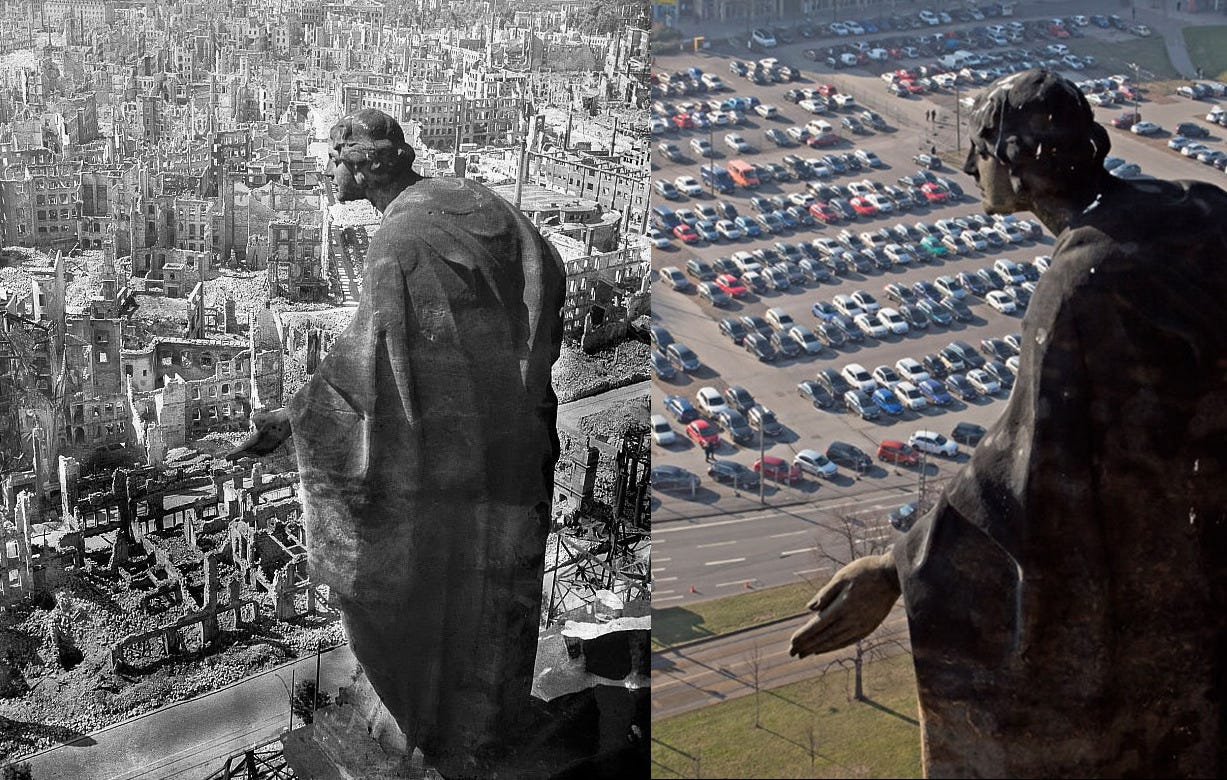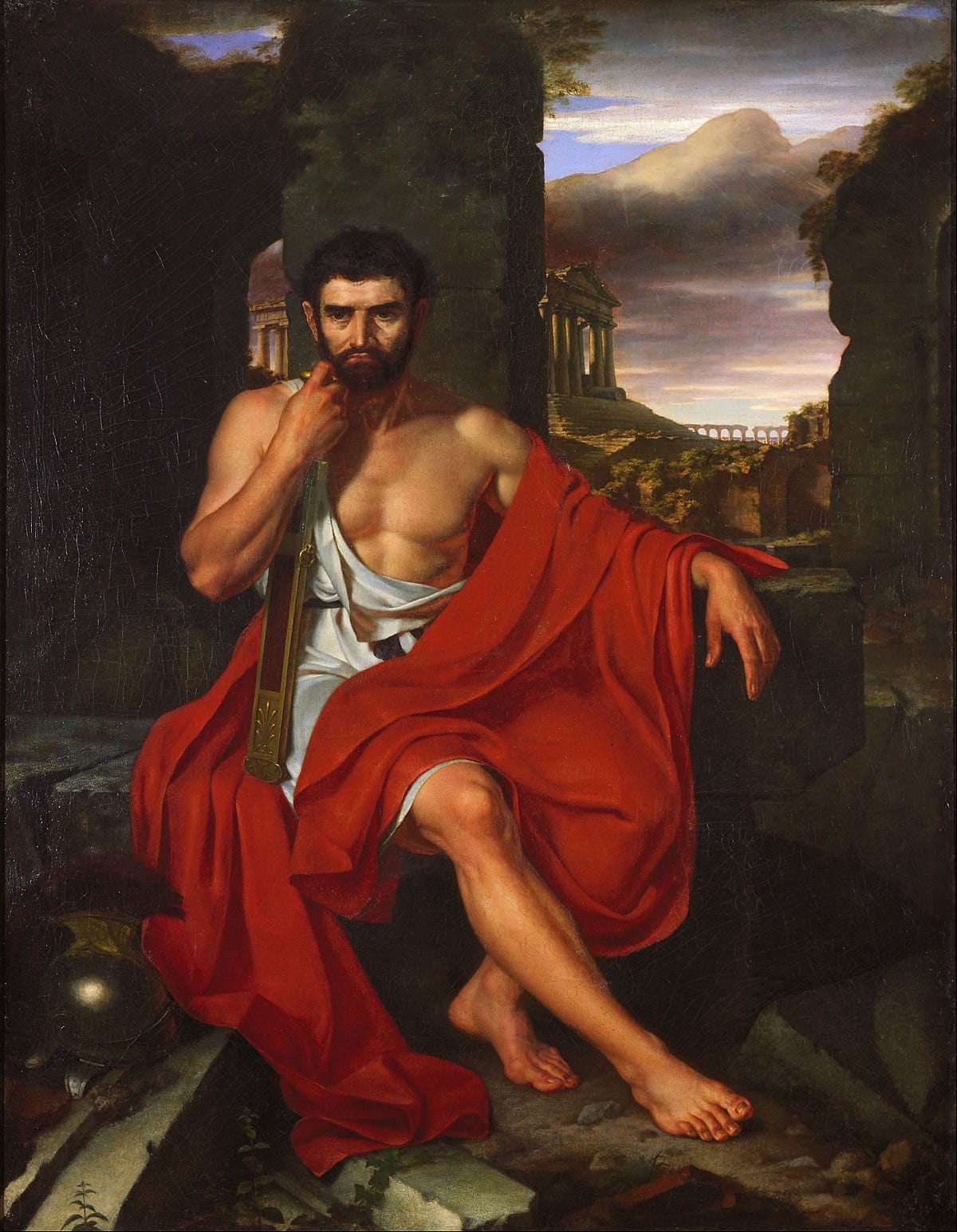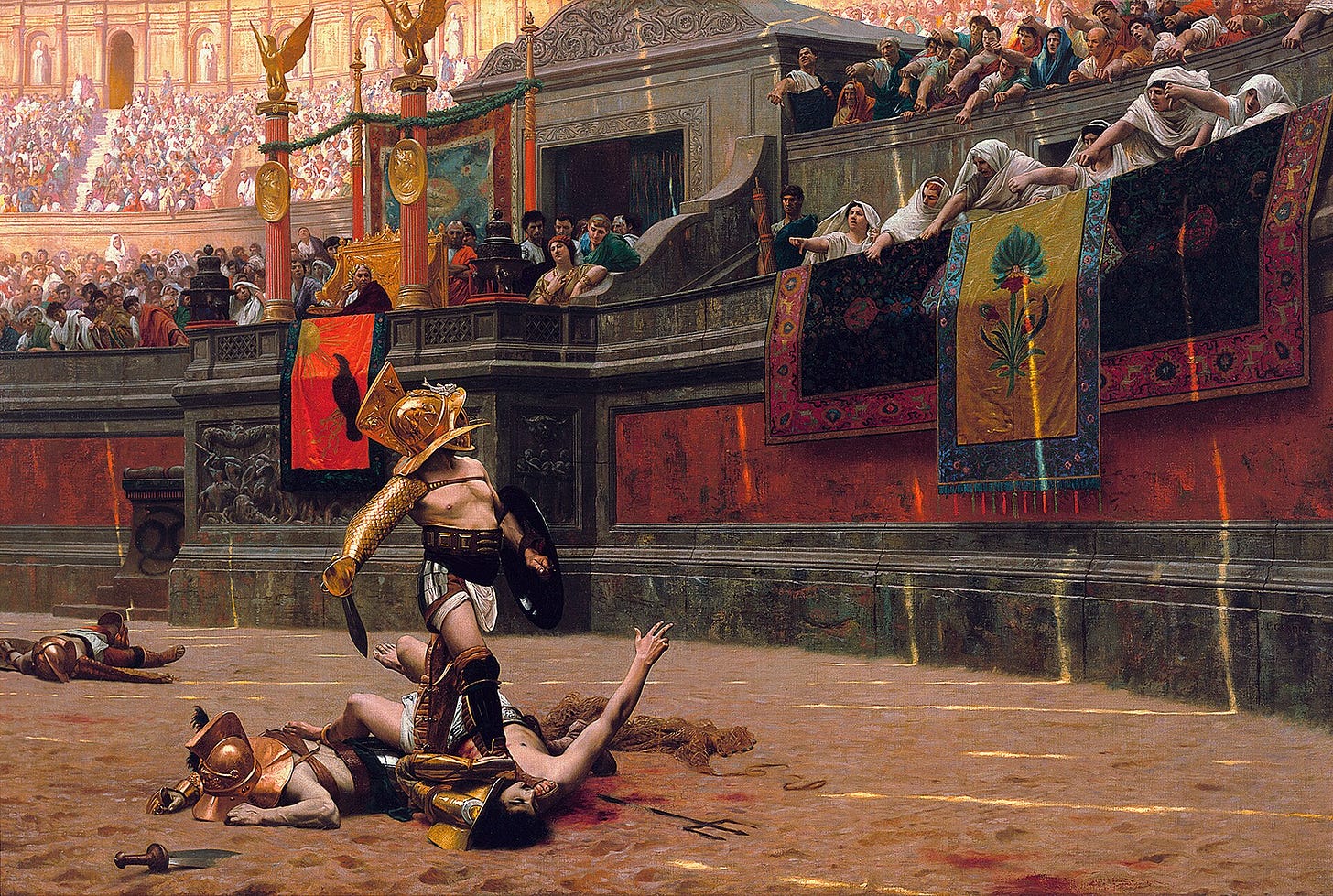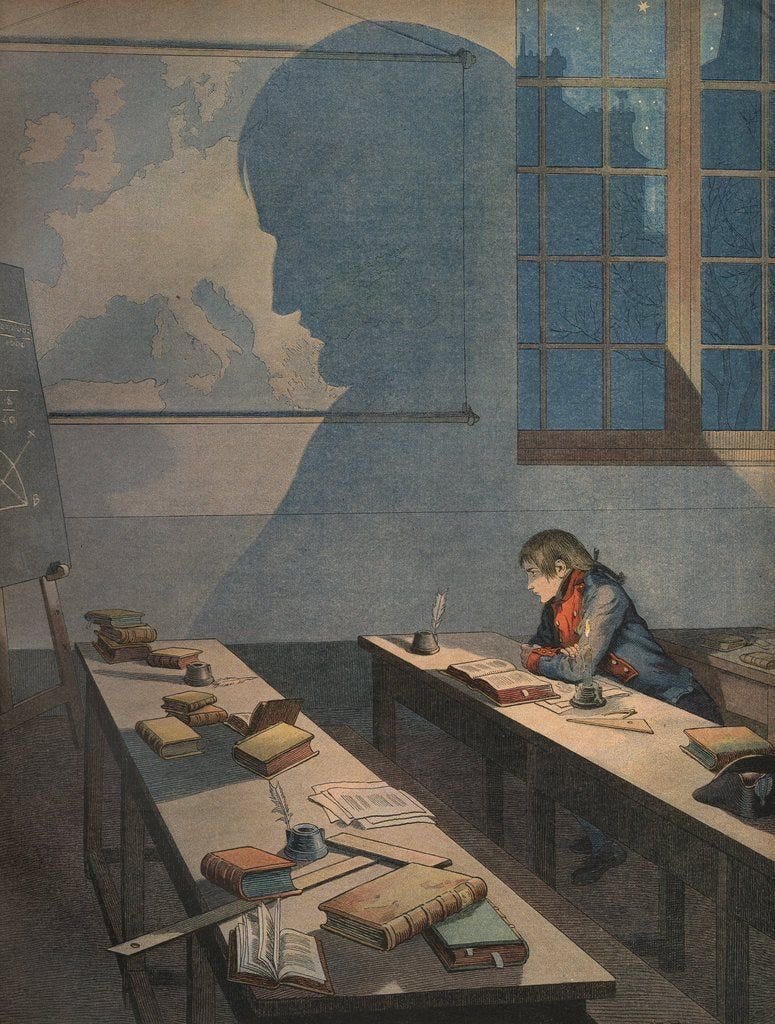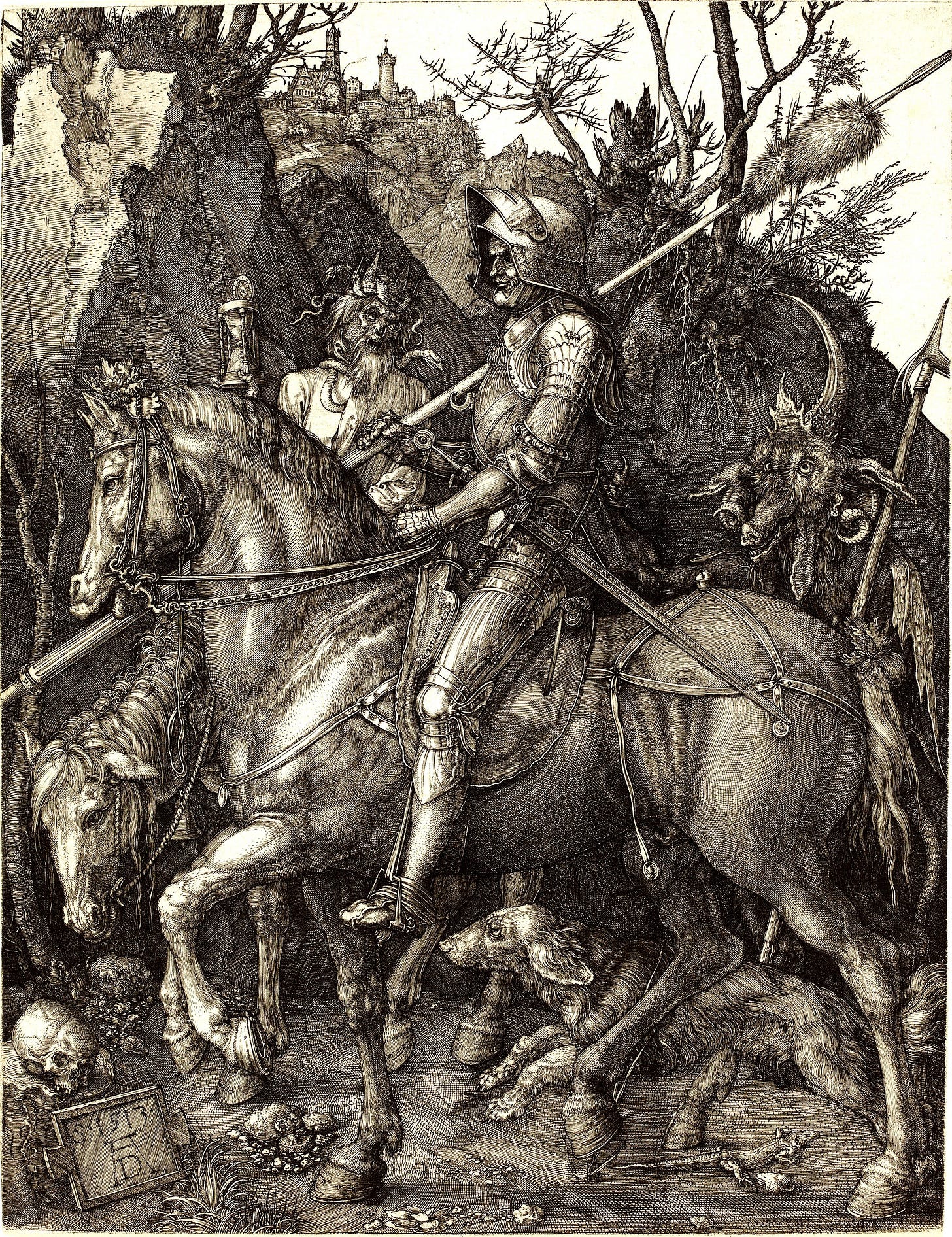The modern West is not a civilization in decline. It is the spectral afterglow of one already dead. Its towers still rise toward the heavens, its machines still hum with borrowed power, its markets still churn with the friction of consumption, but these are the inertial echoes of a spirit that has fled. The soul of the West, once animated by purpose, by hierarchy, by form, has withdrawn. What remains is not a culture, but a husk: a corpse animated not by conviction, but by habit, automation, and the mechanical repetition of once-sacred gestures.
We were not born into a living civilization. We were born into its ruins. Into structures whose forms remain, but whose functions have been severed from meaning. Orphans of a forgotten order, we have inherited not tradition, but its fragments—museum pieces, rituals without reference, words whose original fire has dimmed to embers.
And yet, something in us still remembers.
Not in the shallow sense of nostalgia or sentiment, but in the deep, blood memory of a people shaped by something higher than themselves. A word half-spoken. A gesture from another age. A silence that once carried more truth than the flood of modern speech. These are not mere accidents of memory. They are signs. Traces. Echoes of a civilizational form that once ordered life from the soul outward, that taught men not just how to live, but how to aim.
This remembrance does not belong to any one man. It is not psychological. It is civilizational. A deeper layer of memory than mere autobiography, one etched in stone, in scripture, in song, in blood. It is Plato’s anamnesis, the recollection of something eternal. It is the stirring of a dormant spirit, not yet awake, but no longer wholly asleep. It rises not in comfort, but in moments of rupture: in the fury at cowardice, in the quiet refusal to kneel before absurdity, in the longing for order in a world that denies all measure.
We mistake this awakening for pain because it tears at the illusions of peace. But what stirs in us is not sickness. It is the first sign of returning life.
The corpse twitches.
The flame, though faint, is not yet extinguished.
And it is here, in this ambiguous threshold between the end of one world and the beginning of another, that we must learn to remember rightly.
Civilization does not vanish in a single stroke. It decays from within. It forgets its gods, doubts its destiny, and lets its edges blur. What once was sacred becomes optional, what once was beautiful becomes impractical, and what once was commanded by duty becomes governed by appetite. The collapse arrives not as a cataclysm, but as a quiet erosion. Day by day, the form is replaced by function, beauty by comfort, discipline by indulgence. The soul of the people is reshaped not by conquest, but by concession.
And then, one morning, the illusion breaks. Men look up and see that the temples are hollow. Their leaders no longer inspire fear or reverence, only shame. The young no longer resemble the old. The language that once bound them has become alien, filled with words they cannot translate. What was once civilization has become machinery without meaning.
Yet even among ruins, not everything is lost.
The man who walks these broken halls must understand: we are not living after tradition, but under its denial. The rites and myths have not been erased. They have been buried. They have been mocked, commercialized, distorted beyond recognition, but the root remains. What collapses is not tradition itself, but the degenerative scaffolding that tried to outgrow or replace it. The modern world has not refuted tradition. It has only forgotten how to hear it.
Tradition is not a shadow cast from the past. It is a foundation beneath us. Not nostalgia, but bedrock. Not decoration, but fire, buried now, but unextinguished. It is the primal memory of form, of order, of measure. What is lost can be remembered. What is buried can be uncovered. But only by those who have the courage to descend through ash and ruin and recover what modernity has tried to discard.
This is the task of the man who seeks to reforge himself. Not to mourn the ruins, but to read them. Not to lament what has fallen, but to study its shape. For ruins are not simply remnants. They are messages. They are blueprints. The broken column reveals what once stood upright. The shattered altar still whispers of what was once worshipped. Every ruin testifies not merely to death, but to possibility.
But possibility alone is not enough. It must be seized. The man who is content to manage decline, to make peace with entropy, is no less a traitor than the one who helped tear the old world down. Only those who remember that greatness once was, and can be again, will have the strength to build beyond the rubble.
Tradition waits. But it does not wait forever.
To live among ruins and do nothing is cowardice. But to live among ruins and remember is a sacred act. It is to reach through the ash and pull forth the sword still lodged in the stone—not as a symbol of nostalgia, but as a declaration that form still lives, and that the soul of man can still be forged anew.
We are not here to curate debris. We are here to restore direction and elevation. Civilization is not preserved by conserving its remnants, but by reviving its inner fire. The ruins are not only what remains after collapse. They are the outlines of what once stood and the possibility of what can stand again.
Tradition is not the past. It is the principle that made the past possible. It is not frozen in time but rooted in eternity. It is the vertical axis that binds the mortal to the divine, the transient to the permanent, the lower to the higher. It is the same axis the Platonists called the anagoge—the upward path of the soul—and that the medieval mind saw in the Great Chain of Being, stretching from the mineral to the angelic in ordered ascent. It is not an aesthetic preference. It is a metaphysical orientation.
The man who thinks tradition is a matter of costumes, customs, or nostalgia is playing dress-up in a tomb. Tradition is not what we were. It is what we are when we align with what we must become. The Greek aristos, the Vedic kṣatriya, the Platonic Guardian—each reflects a higher anthropology, a recognition that man is not merely flesh, but form; not merely an organism, but a vessel of order.
In every true people, there exists a pattern, a form of being that transcends individual will and endures across generations. It speaks through more than words. It lives in how men build, how they walk, how they sing, how they stand before death. It manifests in temples and swords, in rites and taboos, in posture and praise. It is not static. It is rhythm. What Heraclitus called logos. What Confucius would call li—ritual as the outward expression of inner harmony.
And it orders the soul.
It places spirit above impulse, beauty above utility, duty above convenience. It binds man to a higher standard. To live without this orientation is not liberation. It is collapse into formlessness. The man without tradition is a man without measure.
Tradition teaches aim. Not in the modern sense of goals or productivity, but in the ancient sense of telos—the end toward which all things should strive. That aim is aretē (ἀρετή), not comfort, not success, not self-expression, but excellence in its true, metaphysical sense. The fulfillment of one’s nature according to a higher cosmic law. As Aristotle taught, man is a rational animal, but becomes fully man only when he lives in accordance with reason rightly ordered toward the good. As Plotinus said, “Never stop sculpting your own statue.”
To live traditionally is to live not as a mere consumer, but as a participant in a divine order. It is to ask not “What pleases me?” but “What is required of me?” The question is not pragmatic. It is liturgical. The traditional man stands before the sacred not as a beggar, but as a servant. His life is not his own. It is a task. A trial. A ladder.
This is the essence of nobility. Not wealth. Not pedigree. But vertical commitment.
To live among ruins and rise is not a metaphor. It is initiation. And it begins here.
To live traditionally is not to mindlessly obey some long dead superstition. It is to submit to form. Not form as outward appearance, but form as metaphysical structure—the invisible order that gives shape to being. In a traditional world, the highest does not simply rule the lower. It ennobles it. Spirit governs matter not through coercion, but through clarity, as light orders space. And the lower obeys, not as a slave, but as one uplifted by contact with that which transcends.
Hierarchy, rightly understood, is not oppression but elevation. This was known to all civilizations before the modern rupture. From the dharma of ancient India to the Hellenic vision of the kosmos, where gods, men, and nature each held their ordained place, the world was seen as an ordered whole in which every level had its purpose, its limit, and its orientation toward the divine. What the West once called nature’s law, the East called the Tao. Julius Evola called it the axis mundi. Plato called it the Form of the Good.
To live in alignment with this axis is to reintroduce weight into a world that floats. It is to bring measure where there is excess, silence where there is noise, structure where there is sprawl. The man of tradition does not merely endure collapse. He refuses to dissolve within it. His stance itself becomes resistance. He does not drift. He orients. He becomes the pillar that remains when the temple falls.
This is how civilizations rise—when men become vertical beings again. Not creatures of appetite, but bearers of form. And this is how civilizations fall—when men forget the vertical and live only in the horizontal.
We do not live in continuity. We live in the aftermath of a severance. Not merely a revolution in politics or economics, but in ontology itself. Something essential was broken. The sacred canopy that once covered man was torn away. The transcendent was exiled. And in its place stands not simply an emptiness, but its opposite. What now governs us is the antithesis of tradition. It is not rooted. It is rootless. It is not alive. It is sterile. It is not an order at all, but a simulation of order, built upon the denial of essence.
Where tradition affirmed hierarchy, this regime enforces equality. Where tradition upheld sacrifice, this regime promises comfort. Where tradition demanded remembrance, this regime commands forgetting. Its aim is not transcendence, but consumption. Its sacred is the self. Its liturgy is transaction. It has no saints, only influencers. No temples, only data centers.
This is not merely a political inversion. It is a metaphysical inversion. As René Guénon foresaw, the reign of quantity now defines our age, reducing all things to what can be measured, exchanged, and sold. As Martin Heidegger warned, Being itself has been forgotten, and in its place stands endless technical manipulation. We live in the shadow of a revolt against the Real.
And so the crisis we face is not one of policy or party. It is a crisis of being. Of identity. Of destiny. The modern West promised the fruits of reason and the peace of perpetual management, but it delivered a civilization anesthetized against suffering and incapable of greatness. It gave its children luxuries, but no fathers. Rights, but no roots. It trained them to hate the very blood that bore them, to desecrate their inheritance, and to dissolve into a global monoculture with no memory and no mission.
But history does not vanish. It recedes, and then returns. It waits beneath the surface like a buried god. And when it rises, it does not come gently. The illusions are beginning to crack. The slogans no longer stir the soul. The market has fallen silent. The rituals of liberalism repeat, but they no longer mean. The spell is breaking.
And what comes next will not be decided by systems, but by souls.
And in the wreckage, the Western man begins—dimly, haltingly—to remember. Not the caricature drawn by modern ideology, nor the passive role assigned to him by global bureaucracy, but the deeper truth etched into the marrow of his being. What awakens in him is not a concept, but a metaphysical tension. A pull upward. The return of the vertical axis.
It begins with instinct. The longing for order. The thirst for greatness. The revulsion toward cowardice. These are not mere reactions. They are the residue of a soul that once stood in alignment with Being. The memory of what it meant to be formed according to the Real. To live with direction, hierarchy, and weight. These instincts are not psychological quirks. They are echoes of anamnesis, what Plato described as the soul's recollection of eternal truths before it descended into matter.
This breaking point is not the end. It is the threshold. A liminal space between what decays and what might yet be reborn. It demands not despair, but decision. We will either cross it by reclaiming our form or vanish without ceremony. What lies ahead is not a slope into decline, but a moment of judgment. The crisis is ontological.
Civilizations do not survive through memory alone. Memory must be given flesh. It must incarnate. In ritual, in architecture, in law, in posture. A civilization endures only when memory becomes form, and form becomes life. Our ancestors understood this with instinctive clarity. They built the city as reflection of the cosmos, the temple as axis between heaven and earth, the family as microcosm of divine order. The forms they built were not merely functional. They were sacramental.
But the modern world, unlike the tempests that once came from without, did not shatter these forms through force. It desecrated them in silence. It did not topple the columns. It hollowed them. It left the altars standing, but stripped them of flame. The family remains as a legal arrangement, but no longer initiates the soul into belonging. The church stands as stone, but no longer speaks with eternity. The state still commands, but forgets whom it serves. The school instructs, but no longer inherits. What endured the sword has not endured the forgetfulness.
What remains is a world of surfaces. Process without essence. Mobility without destiny. A world that exalts consumption over contemplation, and novelty over knowledge. A civilization that denies any transcendent referent must inevitably collapse into relativism, and relativism into nihilism.
But form is not a memory. It is a metaphysical constant. It is that which allows anything to be intelligible at all. Without form, there is no meaning—only flux. The soul, too, has a form. And when that form is remembered and reasserted, man once again becomes capable of bearing order into the world.
To live according to tradition is not to copy the dead, but to make present the eternal. It is to root one’s existence in the Real. To arrange soul and society in harmony with logos, the divine reason that gives order to all things. The traditional man does not merely react to chaos. He restores proportion, symmetry, and rhythm. His existence is the reimposition of taxis over the chaos of the formless.
This is the primordial battle. Not between ideologies, which come and go, but between form and formlessness. Between the structured cosmos and the dark waters of dissolution. Between logos and chaos. Between memory incarnate and memory erased. The bearer of tradition is not a partisan. He is a pole. A still point in a turning world.
In his silence, there is measure. In his gaze, orientation. In his discipline, law.
To restore the West, we must become such men again.
Men of form.
The crisis we face is not merely political or demographic. It is metaphysical. It concerns the kind of life we live and the kind of beings we are becoming. A civilization may survive war, plague, and poverty, but it cannot survive the loss of its orientation toward the Real. A world without gods, without fathers, and without form does not produce freedom. It produces man without measure. He may be fed, stimulated, and surrounded by information, but he is no longer shaped by anything higher than his own desires. He is not free, but unbound. Not sovereign, but drifting. Not modern, but disfigured.
To reject this is not merely to resist decay. It is to affirm order. It is to reassert the vertical structure of reality. The ancients saw this structure as the cosmic axis, the ordering principle that binds earth to heaven, body to soul, time to eternity. What must be affirmed is not a policy or a party. It is a way of life. A life conformed to logos, aligned with the inner grammar of the world, attuned to what Plato called the music of the spheres.
Such a life begins not in rebellion, but in recollection. The soul must remember what it once knew. This is not metaphor. It is metaphysics. To live traditionally is to make this return real. It is to live as if the Good exists, and to shape one’s soul accordingly.
This way of life does not mimic the past. It embodies the timeless. It seeks the permanent within the transient, the essential within the accidental. It places order before appetite, duty before indulgence, and hierarchy before leveling. It sees in structure not a constraint, but an image of the divine. Hierarchy is not an imposition. It is a reflection of the ontological order itself.
It is a life of virtus, in the Roman sense. Not strength for its own sake, but strength as moral form. Character as internalized law. Self-command as the precondition for civilizational command. This life does not wait for institutions to bestow meaning. It does not beg modernity for purpose. It imposes form upon the soul, so that the soul may bring form back into the world.
This is not a path for the crowd. It is not democratic. It is aristocratic in the true sense. Not because it excludes, but because it ascends. It calls to those who would live by a higher measure, who would shape themselves according to something eternal. It begins in solitude, in recollection, in discipline—but it does not end there. For those who ascend become builders. Their being becomes architecture.
To live this way is already to stand apart. But it is more than resistance. It is foundation. It is preparation. The false idols of modernity—progress without telos, equality without order, freedom without truth—will collapse. What has been built on the denial of Being cannot last. When it falls, it will not be the analysts who restore the world. It will be the men who carried the flame. The men who remembered.
We have inherited ruins. But we are not condemned to be debris. To live with form, with memory, with measure is not escapism. It is resurrection. We are not the final echoes of a dying civilization. We are the first chords of its return.
What was buried can rise again. What was desecrated can be sanctified. The flame that flickered in our fathers can burn in us once more. Not to illuminate the old temples, but to raise new ones on sacred foundations. The man who remembers does not weep. He builds. He does not copy tradition. He incarnates it. Through discipline. Through creation. Through the silent defiance of a soul that still knows how to kneel, how to rise, and how to forge anew.
To kneel before the eternal is to rise before the world.
To rise is to build.
And to build is to begin again.
The time of awakening has come. Not for the world. For us.




